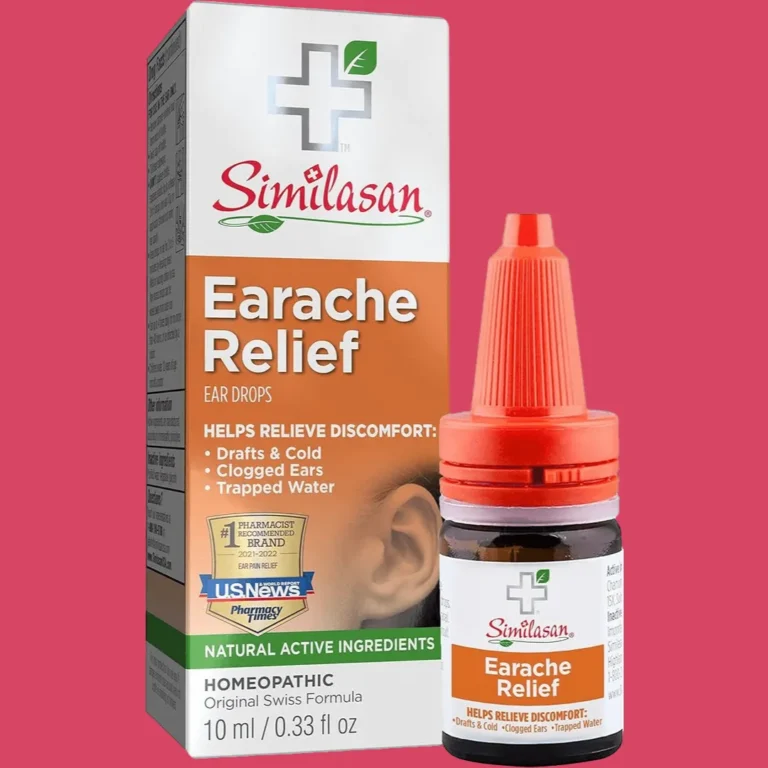Home Remedies for Ear Infection
Picture a child, tugging at their ear, a look of discomfort painting their innocent face – a common image of an ear infection’s distress.
Ear infections are a prevalent health challenge, striking individuals across all age groups, with varying clarity on its origin and treatment.
Before diving into the subtleties of home care, it’s crucial to grasp the basics of what constitutes an ear infection, its symptoms, and its many forms.
The throbbing pain, the muffled hearing, or even the mild fever – these are telltale signals that suggest the presence of an ear infection, which can range from the outer to the middle ear.
Factors such as age, exposure to smoke, and a history of recurrent infections can elevate the likelihood of this unwelcome ailment.
While professional diagnosis and medicinal options are vital, there’s a treasure trove of home remedies at one’s disposal, each promising their own brand of relief.
In the following article, we delve into the realm of ear infection home remedies, spotlighting methods like warm and cold compresses, the relief that comes with an upright position, and the utility of heating pads.
We’ll also glance at over-the-counter medications poised to aid those suffering and discuss measures to prevent future infections, offering a beacon of hope for those eager to find solace in the sanctuary of their own homes.
Table of Contents Home Remedies for Ear Infection
Understanding Ear Infections
Ear infections can affect anyone at any age but are particularly common in children due to anatomical and immune system factors.
There is a multitude of reasons why ear infections may occur, and understanding the types and causes is the first step in seeking effective treatment and relief.
Overview of Ear Infections
Ear infections are generally categorized into three types, each affecting different parts of the ear:
- Outer ear infections (Otitis externa) – These infections affect the ear canal and are often referred to as “swimmer’s ear.
- ” They are typically caused by bacterial infections of the skin tissue covering the ear canal.
- Middle ear infections (Otitis media) – These are the most well-known type of ear infection, characterized by fluid and pus trapped behind the eardrum.
- Often ensuing from common colds, these can be caused by both bacterial and viral pathogens.
- Inner ear infections – These are less common and are usually due to viral infections.
- They are also referred to as labyrinthitis or vestibular neuritis and can cause balance and hearing issues.
Symptoms can range from severe ear pain, fluid drainage, trouble hearing, and signs of dehydration, especially in young children.
You may also notice some affected individuals tugging at their ears or exhibiting increased irritability.
In many cases, prompt medical attention is advised to get a correct diagnosis and treatment to prevent any complications.
Causes of Ear Infections
Understanding the causes of ear infections can help in both prevention and treatment.
The reasons for these painful conditions vary based on the type:
- Middle ear infections commonly result from fluid buildup when a person has a cold.
- This fluid harbors bacteria or viruses leading to infection.
- Children’s Eustachean tubes—the narrow passages connecting the middle ear to the back of the throat—are shorter and more horizontal than those in adults, making it easier for pathogens to reach the middle ear and cause infection.
- Outer ear infections, on the other hand, can be caused by moisture trapped in the ear canal, often from swimming, which creates a breeding ground for bacteria.
- At times, a break in the skin of the canal can also facilitate a bacterial infection.
- Inner ear infections are less common and are most often caused by a virus affecting the hearing and balance organs.
- These infections can be accompanied by symptoms that affect balance, such as vertigo and dizziness.
Children are particularly prone to ear infections due to their developing immune systems’ inability to effectively combat infections.
Additionally, the onset of symptoms following a cold can suggest the likelihood of an ear infection, with issues typically arising around day three of a respiratory illness.
Utilizing Home Remedies for Ear Infection Relief
While seeking professional medical treatment is crucial for ear infections, especially when they are severe or persistent, there are home remedies that can help alleviate some of the discomfort associated with mild cases.
These remedies can be used as complementary treatments alongside prescribed medications from healthcare providers.
Remember, if symptoms persist or worsen, it is imperative to consult a healthcare professional.
- Warm compresses: Applying a warm compress can help relieve ear pain and discomfort.
- Simply soak a washcloth in warm water, wring it out and hold it against the affected ear for intervals of a few minutes.
- Elevated position: If you are suffering from an ear infection, try to keep your head elevated, especially when lying down.
- This can help promote fluid drainage and reduce pressure in the ear canal.
- Garlic oil: Known for its antimicrobial properties, garlic can be a natural method to alleviate pain.
- Create garlic oil by infusing crushed garlic cloves in warm olive oil, then straining the mixture.
- Apply a few drops to the affected ear as long as the eardrum isn’t perforated.
- Hydration: Drinking plenty of fluids can help thin out mucus associated with ear infections, promoting drainage and ease of congestion.
- Herbal ear drops: Various herbal preparations with antimicrobial and anti-inflammatory properties may provide some relief.
- Ingredients like calendula, mullein, St.
- John’s wort, and tea tree oil are common, but make sure to consult with a healthcare professional before use, particularly in children or if you have a perforated eardrum.
- Avoid irritants: Limit exposure to secondhand smoke and other irritants that can aggravate the condition and interfere with the healing process.
In summary, while these home remedies can provide temporary relief from the symptoms of an ear infection, they do not replace professional medical care, especially in the case of severe or recurrent ear infections.
It is always advisable to consult with a healthcare provider to receive a proper diagnosis and appropriate treatment.
Symptoms of Ear Infections
Ear infections are an uncomfortable condition, often marked by noticeable symptoms that can affect both adults and children.
Among the most common sign is ear pain, which may be constant or come and go.
Individuals might also experience a feeling of pressure or fullness inside the ear.
If the infection progresses, pus-like drainage from the ear canal is possible, and some may notice a temporary reduction in hearing capacity.
Children suffering from ear infections can exhibit additional physical behaviors such as pulling or rubbing at their ears or expressing more fussiness than usual.
Parents might also observe fever, trouble sleeping, frequent loss of balance, headaches, and a decrease in appetite in their little ones.
While symptoms of ear infections typically resolve in a few days, lasting fewer than three and seldom persisting beyond a week, it’s important to monitor their severity.
Severe ear pain or high fever, especially above 102°F, requires prompt medical consultation, particularly in infants under 6 months old.
| Age Group | Symptoms |
| Adults | Ear pain, hearing difficulty, fever, fluid drainage |
| Children | Ear pain, restlessness, loss of balance, fever, fussiness |
Remember, while this guide helps identify symptoms, it’s always best to seek advice from a healthcare provider for an accurate diagnosis and appropriate treatment.
Types of Ear Infections
Ear infections can be an uncomfortable and sometimes painful ordeal, and they come in various forms.
Broadly categorized based on the location of the infection, there are two primary types: outer and middle ear infections.
Recognizing which type you’re dealing with is crucial for effective management and swift recovery.
Outer Ear Infections
Outer ear infections, medically termed as “otitis externa” or colloquially known as “swimmer’s ear,” primarily affect the ear canal.
This type of infection is often linked to skin irritation or moisture that leads to bacterial growth.
Imagine the ear canal as a cozy, inviting environment for bacteria, especially after swimming or bathing, hence the moniker “swimmer’s ear.”
Symptoms and Management
- Intense ear pain
- Redness and swelling of the ear canal
- Possible drainage of clear or slightly yellow fluid
Home Remedies:
- Keep the Ear Dry: Avoid water exposure and gently wipe the outer ear with a soft cloth.
- Pain Relief: Use over-the-counter pain relievers like ibuprofen or acetaminophen as indicated on the label for pain.
- Warm Compress: Apply a warm washcloth to the affected ear several times a day to reduce pain and discomfort.
For persistent symptoms or severe infections, a healthcare provider may prescribe antibiotic or steroid eardrops.
Prevention is straightforward and centers around keeping the ears dry and clean, particularly after water activities.
Middle Ear Infections
In contrast, middle ear infections – medically known as “otitis media” – involve the space behind the eardrum where tiny bones vibrate to transmit sound.
Often related to a prior respiratory infection like a cold, this type is characterized by the accumulation of fluid which may become infected.
Symptoms and Management
- A sensation of fullness or pressure
- Hearing difficulty or temporary hearing loss
- Children may tug at their ears and exhibit increased irritability
Home Remedies:
- Elevation: Keep the head elevated to help ease pain and promote fluid drainage.
- Warm Compress: Gently apply heat to the affected area to reduce discomfort.
- Hydrate: Encourage drinking plenty of fluids to help the body fight off the infection.
- Garlic Drops: Garlic has natural antimicrobial properties.
- Crush a clove, soak it in olive oil, and apply a few drops to the affected ear (but only if there is no eardrum perforation).
In cases when pain is severe or does not resolve with home remedies, the infection may require antibiotic treatment, especially in children.
It is important to consult a healthcare provider if symptoms persist or worsen.
Monitoring for symptoms and scheduling an examination can be essential for a timely and effective response to this type of ear infection.
Risk Factors for Ear Infections
Ear infections are a painful reality for many, particularly in children, and various factors can increase one’s chance of developing this condition.
One significant factor is the anatomical structure of the Eustachian tubes in young children; they are short and narrow, making it easier for bacteria to infiltrate and infections to develop.
Additionally, feeding practices influence the incidence of ear infections, with bottle-fed infants showing a higher propensity compared to their breastfed peers.
Environmental factors are at play as well.
Changes in altitude, whether from travel or other activities, can affect ear pressure and precipitate infections.
Cigarette smoke is another culprit, not only aggravating the Eustachian tubes but also increasing the risk of ear infections.
Further risks include recent illnesses that can compromise the immune system, as well as the inherently higher risk observed in males compared to females.
The onset of an ear infection can also be influenced by life circumstances and choices.
For instance, pacifier use, changes in temperature and humidity, low birth weight, and limited access to healthcare services can all add to the risk.
Social factors like daycare attendance increase the likelihood of catching colds, which can then lead to ear infections.
Additionally, certain demographic and genetic factors, such as being of Alaska Native heritage or having a cleft palate, have been associated with a higher frequency of these infections.
Seasonal elements also come into play, with the cooler months of fall and winter often seeing a surge in ear infection cases, exacerbated by poor air quality from factors such as tobacco smoke or air pollution.
Understanding these risk factors is vital for parents and caregivers to help prevent the development of ear infections or to seek prompt treatment when needed.
Age and Ear Infections
Children, especially those between 6 months and 2 years of age, face the highest risk for ear infections.
The physical development of their Eustachian tubes during this stage makes them particularly susceptible.
Additionally, their immune systems are not fully mature, making it harder to fight off infections.
The American Academy of Pediatrics notes that ear infection occurrences peak during this age window, and by the age of 2, half of all children will likely have experienced at least one episode.
While ear infections can occur at any age, they are especially prevalent in youngsters under 2 years old.
Attendance at group daycare settings further elevates the risk, exposing children to a greater number of infections like the common cold, which can lead to subsequent ear complications.
Secondhand Smoke and Ear Infections
Secondhand smoke is a well-documented health hazard that can greatly amplify the risk of developing ear infections.
The irritating chemicals in tobacco smoke have a direct impact on the Eustachian tubes, leading to inflammation and a heightened possibility of infection.
In environments where cigarette smoke is present, both children and adults face increased chances of ear infections.
To safeguard against such infections, avoiding exposure to tobacco smoke is paramount.
This is especially essential for children, whose developing ears are more vulnerable to the harmful effects of smoke.
Ensuring that children’s environments are smoke-free goes a long way towards preventing the occurrence of ear infections.
Recurrent Ear Infections
Recurrent ear infections are not just a source of discomfort; they can lead to more serious conditions, such as mild hearing loss, which, despite being reversible in most cases, can affect speech and developmental milestones in infants and toddlers.
If children suffer from repeated infections and temporary hearing impairment, speech or developmental delays may become apparent due to the disrupted auditory input during critical learning periods.
Moreover, untreated ear infections hold the risk of spreading to nearby areas within the body, especially if treatments fail to resolve the issue adequately.
Persistent ear infections sometimes necessitate more aggressive measures, such as the surgical placement of ear tubes to facilitate fluid drainage and prevent further infections.
Prompt medical intervention is crucial for children experiencing intense ear pain that cannot be relieved with home remedies or over-the-counter medications.
Healthcare providers can offer tailored solutions to combat the cycle of recurrent infections and avoid any long-term consequences.
Diagnosis and Treatment of Ear Infections
Diagnosing an ear infection starts with a detailed account of the patient’s symptoms.
Healthcare professionals use a tool called an otoscope to inspect the ear canal and eardrum for signs of infection.
Sometimes, a pneumatic otoscope, which can puff air onto the eardrum, is used to check for fluid in the middle ear, a common sign of infection.
In more complex cases or when symptoms persist despite treatment, further tests such as tympanometry or audiometry may be necessary to obtain a clearer picture.
As part of the diagnostic process, doctors typically listen to the patient’s breathing using a stethoscope, examine the throat, and nasal passages to check for related issues that could be contributing to the ear infection.
If after these assessments the diagnosis remains uncertain, additional testing can help rule out other conditions and ensure the correct treatment path is taken.
Visiting a Healthcare Provider
For infants under 6 months old with signs of an ear infection, it’s critical to see a healthcare provider early for evaluation and treatment, which usually involves antibiotics.
For older children, a healthcare provider may recommend watchful waiting at first, as some infections improve without antibiotics.
However, if symptoms such as high fever, severe pain, drainage from the ear, or a loss of hearing occur, or if symptoms do not improve after two or three days, seeking professional medical advice is imperative.
During the visit, the healthcare provider will assess the ear for any abnormalities that may require specific treatments.
Medical Treatments for Ear Infections
Ear infections often resolve on their own, and antibiotics are not always necessary, particularly for middle ear infections, which are frequently viral.
When antibiotics aren’t essential, eardrops containing painkillers and anesthetics may be prescribed to alleviate discomfort.
For outer ear infections, treatment options may include antibiotic, steroid, or antifungal eardrops, depending on the type of infection.
In case of severe bacterial outer ear infections, oral antibiotics may also be prescribed.
Following instructions on how to properly use eardrops is key to their effectiveness.
Antibiotics for Bacterial Infections
Antibiotics are reserved for cases of confirmed bacterial ear infections.
These medications work fast to clear the infection and help prevent it from spreading.
Importantly, antibiotics have no effect on viral infections and their unnecessary use can contribute to the development of antibiotic-resistant bacteria.
Physicians prescribe antibiotics judiciously, often waiting a few days to see if the situation improves naturally.
Antibiotics are more likely to be used if there is otorrhea (drainage of fluid from the ear), no improvement after watchful waiting, or other risk factors present.
Antimicrobial Properties of Certain Ingredients
Natural remedies are sought after for their potential to fight infections without the use of pharmaceutical antibiotics.
Garlic oil, for instance, is renowned for its natural antibacterial properties, largely attributed to its component, allicin.
While there are anecdotal claims about the effectiveness of natural oils like garlic in treating infections, evidence for their efficacy in treating inner or middle ear infections is limited.
It’s important to consult a healthcare provider to determine the suitability of such treatments.
Antibiotic Eardrops
For bacterial infections affecting the outer ear, antibiotic eardrops can be very effective.
These are prescribed after a healthcare provider’s examination and are typically used according to specific directions to ensure they work properly.
While some may consider home remedies like antibiotic eardrops, it’s crucial to only use them after consulting with a healthcare provider to ensure they are suitable for the specific type of ear infection and to verify that they will not interfere with other treatments or conditions.
Remember, it is essential to follow the course of treatment prescribed by your healthcare provider to effectively combat ear infections and prevent potential complications.
Home Remedies for Ear Infections
Dealing with ear infections can be painful and uncomfortable, but several home remedies can offer relief from the symptoms.
While it’s important to consult a healthcare provider for any severe or persistent ear infection, especially in children, milder cases can benefit from simple, at-home methods to ease discomfort and promote healing.
Warm Compress
For many suffering from ear pain due to infection, a warm compress can be a soothing solution.
To create one, simply soak a clean washcloth in warm water, wring out the excess, and gently press it against the affected ear for up to 20 minutes.
The warmth can help relieve pain and reduce the sense of pressure in the ear.
Reapply as needed throughout the day, but always check the temperature to avoid burns.
Cold Compress
In contrast to the warm compress, a cold compress can numb the painful area and reduce swelling.
Place a cold pack or ice wrapped in a towel on the affected ear for periods of 10 to 15 minutes.
Remember, alternating between cold and warm compresses might provide better relief as the combination can help manage inflammation and pain effectively.
Upright Position
Maintaining an upright position, particularly when sleeping, can assist with drainage of the middle ear, thereby reducing pain and pressure.
Elevate the head with extra pillows or sleep in a recliner to keep the body propped up.
Chewing gum may also alleviate discomfort caused by ear pressure changes, such as during airplane ascents and descents.
Heating Pads
Similar to warm compresses, heating pads are an excellent tool for reducing ear pain.
When using a heating pad, ensure it is warm but not too hot, and apply it to the affected area for about 20 minutes.
The heat aids in relaxing nearby muscles and increasing blood circulation, which can help ease discomfort.
Always use a cover to prevent direct contact with the skin and check often to ensure the heat is not causing irritation.
Over-The-Counter Medications
When it comes to medication, over-the-counter analgesics such as acetaminophen or ibuprofen can be effective in managing the pain associated with ear infections.
Dosages should be carefully followed based on age and weight, particularly for children.
Always avoid aspirin for anyone under 18 years old, due to the associated risk of Reye’s syndrome.
Should symptoms persist or worsen, it’s critical to see a healthcare professional for further advice.
In conclusion, these home remedies can be helpful in mitigating the symptoms of ear infections.
However, they are not substitutes for professional medical advice and treatment when needed.
Always consult a healthcare provider if you or your child experience severe or persistent symptoms of an ear infection.
Preventing Ear Infections
To stave off the discomfort and potential complications caused by ear infections, adopting preventative measures is key.
These subtle yet influential lifestyle and health practices can be instrumental in minimizing the risk of developing ear infections:
Avoiding Secondhand Smoke
One of the more effective preventative strategies is the reduction of exposure to secondhand smoke.
Inhaling tobacco smoke can irritate the eustachian tubes, which are responsible for maintaining the pressure and fluid balance in the middle ear.
This irritation can increase the susceptibility to infections.
Creating a smoke-free environment in your home and avoiding locations where smoking is allowed are critical steps in lowering both children’s and adults’ chances of suffering from ear infections.
Maintaining Good Hygiene
Handwashing is your first line of defense against germs that lead to ear infections.
Frequent and thorough handwashing can drastically reduce the transmission of bacteria and viruses.
In addition, staying up to date with vaccines, including pneumococcal and influenza shots, boosts your immunity against these pathogens.
For infants, breastfeeding is recommended for at least the first six months as it provides vital antibodies that protect against various infections, including those of the ear.
Ensuring that ears are appropriately dried after water exposure, such as swimming or bathing, is also essential.
Managing Allergies and Colds
Allergies and common colds can indirectly contribute to ear infections by affecting the eustachian tubes.
Managing these conditions through the appropriate use of allergy medications, decongestants, and maintaining good health practices is important.
Probiotics have shown promise in not only promoting gut health but also boosting overall immunity, which can be beneficial in wardi\ng off ear infections associated with allergies and colds.
Equalizing Ear Pressure
Fluid buildup and pressure in the ears can be uncomfortable and can lead to infections.
You can aid drainage and relieve pressure by sleeping or resting with the affected ear uppermost, thus making gravity work in your favor.
Additionally, OTC fluid-drying eardrops may be beneficial, especially for outer ear infections (“swimmer’s ear”).
For natural remedies, basil juice possesses antimicrobial properties, which can be gently applied around the ear, not inside the canal, to support ear health.
Using Ear Protection in Noisy Environments
Consistent exposure to loud noises can be detrimental to ear health and may strain the eustachian tubes, increasing the risk of infection.
Ear protection, like earplugs or noise-canceling headphones, should be employed in noisy environments to safeguard the ears.
This is not only vital in preventing temporary discomfort or hearing loss but also in reducing the chance of developing ear infections due to ongoing auditory stress.
Adhering to these preventative measures can greatly reduce your risk of getting an ear infection and improve your overall ear health.
Small changes can have a significant impact on preventing the discomfort and potential hearing loss associated with ear infections.







